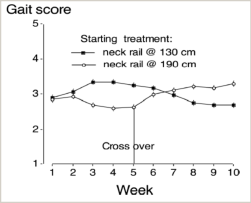



Moving The Neck Rail May Help Lame Cows
A recent research report by the University og British Columbia, Dairy Education and Research Centre has showed how lame cows recover rapidly when provided access to pasture.Just two weeks on pasture led to improvements in gait of lame dairy cows. Cows that stayed in a free stall barn showed no improvement. Of course pasture access is not always possible, for example during the wet winter months.
The next question raised by researchers Dan Weary and Marina von Keyserling was whether indoor housing could be modified to allow similar benefits? Specifically, can changes to freestall barns provide similar benefits for lame cows?
Standing outside of the stall (typically on wet concrete) increases the risk of lamness. One aspect of the stall that especially affects where cows stand is the position of the neck rail. If stalls could be custom fitted for each cow, the neck rail would be positioned so that each cow could lie down and stand up comfortably in the stall, but while standing she would be 'indexed' so that her urine and feces fall in the alley outside of the stall. Unfortunately, cows come in a wide range of sizes, and this 'fit' is hard to get just right.
Both the height of the neck rail and its distance from the curb affect standing behaviour; more restrictive neck-rail placements (lower and closer to the rear of the stall) prevent cows from standing fully in the stall. Preventing the cow from standing in the stall is one way to keep stalls clean, but has the unfortunate effect of forcing the cows back onto the wet concrete outside of the stall.
In a recent study, the researchers showed how neck rail placement affects the cows' ability to stand in the stall. Cows were tested with neck rails positioned over the range of values found on commercial farms; ranging from a restrictive placement of 130 cm from the rear curb, to a much more generous 190 cm from the curb.

As can be seen in Figure 1, the more time the cow spent perching (standing with the front hooves in the stall) and the less time she was able to stand fully in the stall. This clear result gave usMr Weary and Ms Keyserling an idea. They knew that standing outside of the stall increases the risk of lameness, and now they also saw how a simple aspect of stall design can change where the cows stand. Could an environment be created that would help lame cows recover simply by moving the neck rail?
Lameness takes weeks to develop and weeks more for cows to recover, so in our next experiment we tested cows for 10 weeks. This time just the two extreme positions from the previous study were tested, 130 and 190 cm from the rear curb. Cows were housed in pens with the neck rail in one position or the other for the first five weeks. Treatments were then switched ('crossed over') and the cows were observed for another five weeks. Every week cows were gait scored using the UBC scoring system; cows with perfect gait are scored 1, and severely lame cows are scored 5. Scores of 3 or greater are considered clinically lame.
Again, the results were clear. When provided stalls with the more generous neck rail placement (190 cm from the rear curb), the cows spent more time standing with all 4 hooves in the stall and less time 'perching' with just the front two hooves in the stall. As expected, this change in behaviour resulted in a change in lameness. Figure 2 shows how gait changed over the 5 weeks tested with each position. When cows were housed with the neck rails positioned permissively at 190 cm gait improved, and gait worsened when kept in pens with the neck rail at 130 cm.

13 new cases of lameness were recorded over the experiment, but only two of these occurred while cows were in pens with the neck rail at 190 cm. Also as expected, stalls in these pens were more likely to become contaminated with feces and urine; however, we saw no increase in the number of clinical or sub-clinical intra-mammary infections.
This study provides the first experimental evidence that changes in stall design can reduce the risk of lameness. The results also illustrate how changes in design that result in improvements in cow comfort and lameness can come at the expense of cow and stall cleanliness.
From the researchers perspective the benefits exceed the costs associated stall maintenance. However, a better option would be housing that keeps cows clean and reduces the risk of lameness. Well managed pasture can do just this, but most dairy producers also require indoor housing. Their aim now is to develop housing systems that provide both a suitable environment for the cow to stand (thus reducing the risk of lameness), and a clean, dry lying surface that promotes cow comfort and udder health (thus reducing the risk of mastitis).


